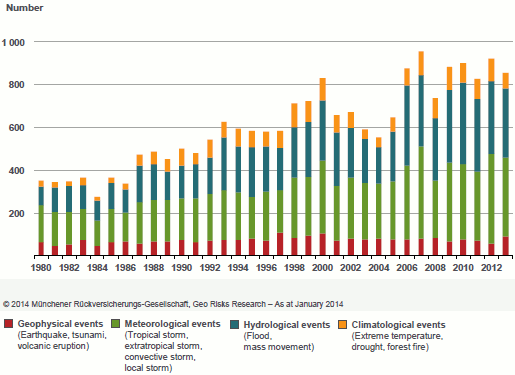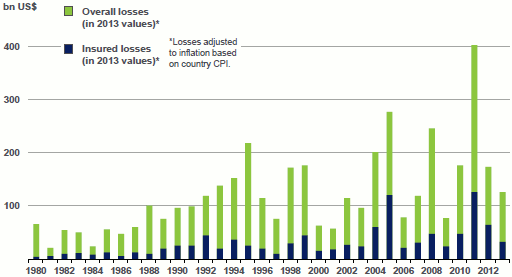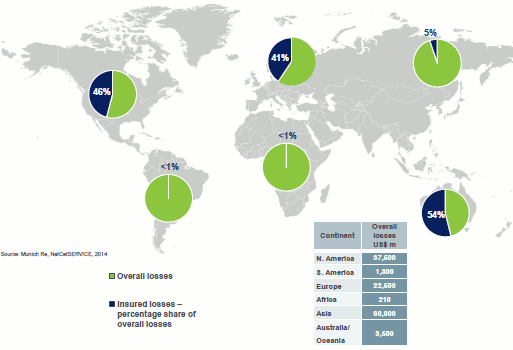The regional breakdown of global insured natural catastrophe losses in 2013 was vastly different to that experienced in 2012, as Europe saw significant losses from extreme weather events and the U.S. experienced a benign hurricane season, shows data from Munich Re.
The world’s largest reinsurer Munich Re has published its preliminary estimates of 2013 global economic and insured natural catastrophe losses today. 2013 saw exceptionally high losses from extreme weather events in Europe, resulting in the continent suffering almost double the 1980 to 2012 mean insured losses. Supertyphoon Haiyan was the other catastrophe event which stood out, causing a human catastrophe with 6,000 plus deaths but once again demonstrating the lack of insurance penetration in the region.
Munich Re puts 2013 economic losses from natural catastrophes at $125 billion and insured losses at approximately $31 billion, both numbers below the ten-year averages of $184 billion and $56 billion. The 2013 insured loss total is even just below the 30 year average, which shows just how low the figure is. In 2012 the insured loss figure was considerably higher at $65 billion while economic losses were $160 billion, according to Munich Re’s 2012 report.
That means that just over 40% of economic losses from natural catastrophes were insured in 2012, while in 2013 that percentage was significantly lower at 25%. The reason for this is likely that losses were more widely distributed around the world, in 2012 90% of insured losses were in the U.S. (compared to just 54% in 2013). The lack of hurricanes, a well covered risk typically with high insured to economic loss ratios and the fact that as a market the U.S. has one of the greatest insurance penetrations for property cover, as well as hurricane Sandy’s impact.
“Several of the events of 2013 illustrated how well warnings and loss minimisation measures can restrict the impact of natural catastrophes. In the case of the most recent winter storms in Europe, for example, the losses remained comparatively low”, commented Torsten Jeworrek, Munich Re Board member responsible for global reinsurance business. “At the same time, events like those in the Philippines show the urgent need for more to be done in developing and emerging countries to protect people better. This includes stabler buildings and protection facilities, and insurance programmes – also with state backing – to provide those affected with financial assistance after a disaster.”
In 2013 Europe accounted for 29% of global insured natural catastrophe losses, much higher than in previous years. Extreme weather events resulting in the flooding in Central Europe and the hail event in Germany were largely to blame. Economic losses from the floods were $15.2 billion, according to Munich Re, while insured losses were $3 billion.
The economic loss from the German hail events totalled $5.2 billion while the insured loss reached $4.1 billion, showing that hail damage is better covered by insurance than the impacts of the floods. These hail events became the largest insured natural catastrophe loss of 2013 for the insurance and reinsurance industry, closely followed by the Central European floods.

Map of 2013 natural catastrophe loss events - Source: Munich Re NatCatSERVICE
While losses, both economic and insured, from natural catastrophes in 2013 were below average, the number of catastrophe events was among the highest experienced in a single year, at 880 loss events. The trend in number of catastrophe loss events per year continues to rise, showing that there is a growing need for more coverage to protect against the impacts of these events.

Number of natural catastrophe loss events worldwide 1980 - 2013 - Source: Munich Re Geo Risks Research
The next chart from Munich Re’s report shows the amount of economic and insured losses from natural catastrophes by year. It clearly shows that 2013 was low for the last ten years, but average beyond that, which demonstrates that loss severity has increased dramatically in recent years.

Natural catastrophe economic and insured losses by year 1980 to 2013 - Source: Munich Re Geo Risks Research
Once again, the natural catastrophe economic and insured loss data drives home the lack of insurance penetration in some regions of the world and the opportunity that this gap can present to insurers, reinsurers and third-party reinsurance capital. With just 25% of the economic losses from natural catastrophes in 2013 paid for by insurers, it shows there is significant work still to do to narrow this gap and improve coverage to better protect the population.

2013 economic and insured losses from natural catastrophes per continent - Source: Munich Re NatCatSERVICE
The graphic above shows that just 46% of U.S. catastrophe losses were insured, 41% of European catastrophe losses were paid by insurers, 54% of Australasia cat losses were insured, but only 5% of Asian cat losses were insured and under 1% of South American and African natural catastrophe losses were insured.
With competition for reinsurance business in developed markets, such as U.S. property catastrophe, particularly high at the moment and the pricing having declined, the world’s reinsurers and third-party reinsurance capital providers are increasingly looking to this opportunity of closing the economic to insured loss gap in emergin markets.
Munich Re board member Ludger Arnoldussen stressed the importance of efforts to bring greater insurance and reinsurance penetration to developing economies, saying; “Insurance programmes – possibly also with state backing – can help provide the people affected with quicker financial support. Studies sponsored by Munich Re have shown that insurance against natural catastrophes in emerging countries has the greatest relief effect in macroeconomic terms.”
More details on the 2013 natural catastrophe insured losses can be found on the Munich Re website.
 View all of our Artemis Live video interviews and subscribe to our podcast.
View all of our Artemis Live video interviews and subscribe to our podcast.
All of our Artemis Live insurance-linked securities (ILS), catastrophe bonds and reinsurance video content and video interviews can be accessed online.
Our Artemis Live podcast can be subscribed to using the typical podcast services providers, including Apple, Google, Spotify and more.































